Similar Posts
____________________________________________________________
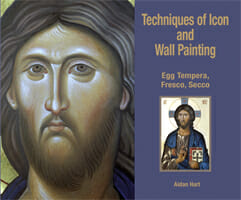 Editorial note: We have convinced Aidan Hart to post a chapter from his new book. “Techniques of Icon and Wall Painting” which is being hailed as the most comprehensive book to date on practicing the art of Iconography. At 450 pages, with 460 paintings, 150 drawings and covering everything from theology and design to gilding and varnishing, it is a prized possession for anyone interested in the traditional arts. The chapter being serialized over the next weeks is called “Designing Icons”. You will see why Archimandrate Vasileos of Iviron called this book the “Confessio of a man who epitomizes the liturgical beauty of the Orthodox Church”. More details about the book on Aidan’s website.
Editorial note: We have convinced Aidan Hart to post a chapter from his new book. “Techniques of Icon and Wall Painting” which is being hailed as the most comprehensive book to date on practicing the art of Iconography. At 450 pages, with 460 paintings, 150 drawings and covering everything from theology and design to gilding and varnishing, it is a prized possession for anyone interested in the traditional arts. The chapter being serialized over the next weeks is called “Designing Icons”. You will see why Archimandrate Vasileos of Iviron called this book the “Confessio of a man who epitomizes the liturgical beauty of the Orthodox Church”. More details about the book on Aidan’s website.
____________________________________________________________
This is part 4 of a series. Part 1, Part 2 , Part 3 (In this section, Aidan give us gives us advice on researching and designing festal icons.)
Written sources
In designing festal icons, it is important to become acquainted with the large range of theological sources relating to feasts and their icons. These are:
- Scripture, especially the readings appointed for the feast. These are given in the service books listed below, or in a church calendar produced each year.
- The liturgical texts of the Orthodox Church, which are the basis for the details of the festal icons. Each feast has hymns written particularly for it, and they express profound theological and mystical truths. These texts are shared among three volumes:
- The Festal Menaion translated by Mother Mary and Archimandrite (now Metropolitan) Kallistos Ware (Faber, London, 1984). This covers the nine of the twelve Great Feasts of the Orthodox Church found outside the Paschal and Pentecostarion season.
- The Lenten Triodion, translated by Mother Mary and Archimandrite Kallistos Ware (Faber, London, 1984). This covers Lenten commemorations falling within the period of Great Lent and Holy Week.
- The Pentecostarion (Boston, 1990). This covers the season from Pascha to the Sunday of All Saints after Pentecost.
- Most of the above service texts may also be found online at www.orthodoxchurchtexts.com
- Apocryphal sources. Many of the hymns in the feasts to the Mother of God are based on events described in a number of these. The chief source is The Book of James or Protevangelion, dating from the second century A.D. Another is The Gospel of pseudo-Matthew.
- Patristic commentaries.
- Contemporary commentaries. A classic here is The Meaning of Icons by Leonid Ouspensky and Vladimir Lossky. This covers the inner meaning of all the major feasts, as well as the main icon types of Christ and the Virgin. Details of this and others are listed in the bibliography.
Your study will make it clear what are the timeless unchanging elements of festal icons, and what can be varied or omitted if appropriate. In the Descent into Hades icon for example, one can have depicted as many as twenty righteous people waiting to be raised by Christ, as in the Moni Chora fresco in Constantinople (1315-1320), to as few as four, as in the early eleventh century mosaic in Hosios Lukas, Greece, or even in extremis, just two – Adam and Eve
Iconographic prototypes
Once acquainted with the theology of the feast that you are designing, gather together a range of its icons. A comparison of these will help you to distinguish the variant from the invariant features.
Observe how the layout of the icons relate to the theological content expressed in the written sources mentioned above, especially the Scriptures and the liturgical texts. In particular discern the ways the following elements are used to express the feast’s theological themes:
- Geometry and proportion. This subject is discussed in the following chapter on geometry and proportion.
- The dynamics of movement. Details should be arranged as part of a whole, whose flow and symmetry emphasizes and offers insight into the inner meaning of the event. Such movement can be suggested variously by: gestures and the positioning of the legs; the leaning of mountains; the relative height and complexity of background buildings; space, which draws movement toward itself.
- Figures illustrate the dynamics typically found in icons of the eighteen major feats. (Editorial Note: We have included only 2 flow diagrams but Aidan’s book contains all eighteen.)
- Garment colour. For a discussion of colour symbolism refer to Chapter Eight on colour and pigments. The Annunciation icon illustrated has the Virgin in an earthy red to emphasize the fact that she gave the Word His humanity, gave Him a body of flesh and blood. The Archangel Gabriel is by contrast depicted in silvery blue and green, to suggest his non-corporeal nature.
The overall colour schemecan also express theological realities. For example the Transfiguration icon illustrated limits itself to a palette of silvery blues and greens to suggest how uncreated light imbues all persons and even the inanimate world of rocks and trees.
-
By contrast this next Transfiguration icon has the disciples in different coloured garments to show that this participation in grace makes more limpid the uniqueness of each person. At the same time their participation in the same heavenly grace is attested to by them all having some blue in their garments.
- The symbolism of buildings. Liturgical texts often use architectural symbols, for example:
The Temple of God, the heavenly Tabernacle, accomplished her entry into the temple of the Law, and from her the Light has shone on us in darkness.
(from Matins of “The Entry into the Temple”)
And in the hymns for the feast of the Annunciation Mary is variously called the living city, spiritual gate, pavilion of the Glory, dwelling for the Maker, throne of the King, and living ark of God.
Some of these images can be seen in the illustrated icon: the throne, the temple suggested by the structure behind her, and the veil drawn aside separating us from the Holy of Holies. This complex structure is deliberately contrasted with the plainer background behind the Archangel, who is a servant sent from God.

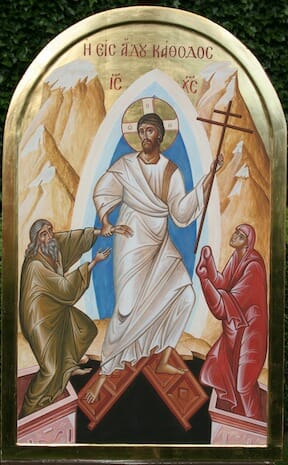
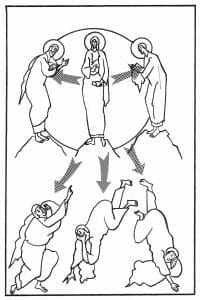
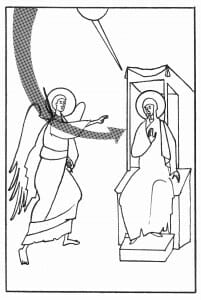
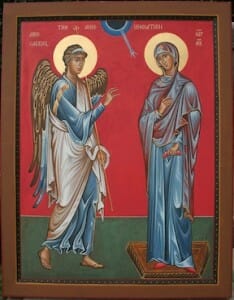
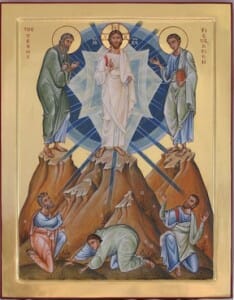
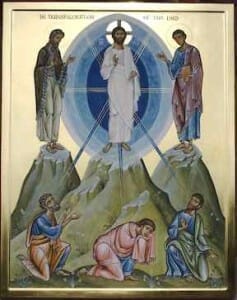
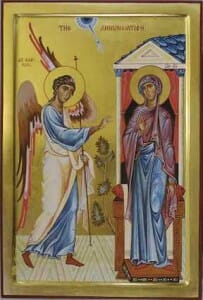
[…] Dec 4th 8:05 amclick to expand…Researching Festal Icons https://orthodoxartsjournal.org/researching-festal-icons/Tuesday, Dec 4th 8:00 amclick to expand…Christ is perfect God and perfect man… […]